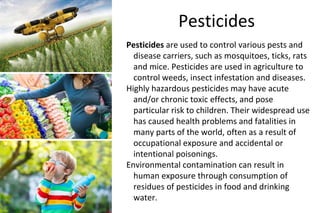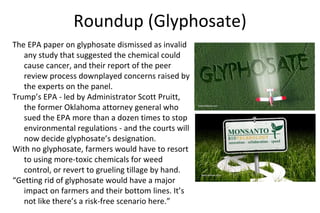Pesticide safety
- 1. Pesticide Safety Draft 8 3 2017
- 2. Pesticides Pesticides are used to control various pests and disease carriers, such as mosquitoes, ticks, rats and mice. Pesticides are used in agriculture to control weeds, insect infestation and diseases. Highly hazardous pesticides may have acute and/or chronic toxic effects, and pose particular risk to children. Their widespread use has caused health problems and fatalities in many parts of the world, often as a result of occupational exposure and accidental or intentional poisonings. Environmental contamination can result in human exposure through consumption of residues of pesticides in food and drinking water.
- 3. Types of Pesticides Types of pesticides include: Algaecides to kill and/or slowing the growth of algae. Antimicrobials to control germs and microbes such as bacteria and viruses. Disinfectants to control germs and microbes such as bacteria and viruses. Fungicides to control fungal problems like molds, mildew, and rust. Herbicides to kill or inhibit the growth of unwanted plants, also known as weeds. Insecticides to control insects. Insect Growth Regulators to disrupt the growth and reproduction of insects. Rodenticides to kills rodents like mice, rats, and gophers. Wood Preservatives to make wood resistant to insects, fungus and other pests.
- 4. Food Quality Protection Act The Food Quality Protection Act (FQPA) was passed unanimously by Congress and then signed into law by President Clinton on August 3, 1996. The FQPA requires that the EPA: make a safety finding when setting tolerances, i.e., that the pesticide can be used with “a reasonable certainty of no harm;” use this new safety standard to reassess, over a 10-year period, all pesticide tolerances that were in place when the FQPA was signed; consider the special susceptibility of children to pesticides by using an additional tenfold (10X) safety factor when setting and reassessing tolerances unless adequate data are available to support a different factor; consider aggregate risk from exposure to a pesticide from multiple sources (food, water, residential and other non-occupational sources) when assessing tolerances; and consider cumulative exposure to pesticides that have common mechanisms of toxicity.
- 5. Pesticide Risks The risk of a pesticide depends on two things, exposure (how much?) and toxicity (how poisonous?): The exposure is the amount you get in or on your body, or the amount that is released into the environment. The toxicity of a pesticide is measure of how poisonous it is to people or the environment. Even products that are low in toxicity can be hazardous if the exposure is high enough. Most pesticides will have either the word CAUTION, WARNING, or DANGER on the label, and that signal word reflects the toxicity of the product: CAUTION represents the lower toxicity products WARNING indicates medium toxicity products DANGER stands for the highest toxicity products
- 6. Minimizing Pesticide Risks Adopt an Integrated Pest Management (IPM) approach: prevention, sanitation and exclusion, and utilizing pesticides only as a last resort when other options have failed. Choose the product lowest in toxicity. Choose products with formulations least likely to lead to exposure. Use PPE to reduce your exposure. Use the appropriate amount of pesticide for your job. Avoid allowing children, pets, or sensitive people in treatment areas.
- 7. Integrated Pest Management (IPM) Integrated Pest Management (IPM) is a combination of common sense and scientific principles. It's a way of thinking about pest management that values: Using knowledge about the pest's habits, life cycle, needs and dislikes; Using the least toxic methods first, up to and including pesticides; Monitoring the pest's activity and adjusting methods over time; Tolerating harmless pests; and Setting a threshold to decide when it's time to act.
- 8. Integrated Pest Management (IPM) These actions are important parts of any IPM endeavor: Identify the pest in the most specific terms possible. Learn about the pest's biology (habits, life cycle, needs and dislikes). Take steps to exclude the pest from the area, if possible. Try to remove the pest's food, water and shelter. Determine the pest's travel patterns and find their home-base. Identify all of your control options (the "tools in the toolbox") before acting.
- 9. Aldicarb In 2010 the EPA targeted aldicarb, known for causing the worst outbreak of pesticide poisoning in North America, to be phased out of use in all world markets by 2015. “Aldicarb no longer meets our rigorous food safety standards and may pose unacceptable dietary risks, especially to infants and young children,” the EPA said. For infants, consumption of aldicarb residue – mostly in potatoes, citrus and water – can reach 800 percent higher than the EPA’s level of concern for health effects, while children between the ages of one and five can ingest 300 percent more than the level of concern.
- 10. Aldicarb On the Fourth of July in 1985, three people who had eaten watermelon in Oakland, Calif., rapidly became ill with symptoms that included vomiting, diarrhea, muscle twitches and abnormally slow heart rates. At the same time, people in Oregon were falling ill, too, and tests of watermelons found extremely high levels of aldicarb, which was illegal to use on all melons. California ordered an immediate ban on watermelon sales, which meant huge quantities had to be destroyed in fields and at stores at the height of the season. How aldicarb got into watermelons remains unknown, but experts suspected that some melon farmers used low levels of it intentionally and illegally and that some also might have flowed off nearby cotton fields.
- 11. Aldicarb That summer, a total of 1,350 cases of aldicarb poisoning from watermelon were reported in California, plus another 692 cases in eight other states and Canada, according to a report by the CDC. Seventeen people were hospitalized. Six deaths and two stillbirths were reported in people who fell ill, but the pesticide was not listed as the cause of death in coroner reports. “The system is designed to leave things like this on the market as long as possible. It’s innocent until proven guilty. It’s really unconscionable that it takes literally decades to do this.”
- 12. Roundup (Glyphosate) Roundup is a weed killer manufactured by Monsanto and widely used on crops in the U.S. and around the world. Monsanto reengineered the DNA of corn, soybeans, and other crops for the primary purpose of making them resistant to Roundup. Farmers spray the chemical on crops grown from Monsanto’s Roundup Ready seeds. The weeds die, harvests expand, and expensive, laborious tillage is no longer necessary. The EPA classified glyphosate, the main ingredient in Roundup, as noncarcinogenic to humans in 1991. In December 2016, the EPA convened a panel to peer review their health assessment of glyphosate, as required for each pesticide every 15 years.
- 13. Roundup (Glyphosate) The EPA paper on glyphosate dismissed as invalid any study that suggested the chemical could cause cancer, and their report of the peer review process downplayed concerns raised by the experts on the panel. Trump’s EPA - led by Administrator Scott Pruitt, the former Oklahoma attorney general who sued the EPA more than a dozen times to stop environmental regulations - and the courts will now decide glyphosate’s designation. With no glyphosate, farmers would have to resort to using more-toxic chemicals for weed control, or revert to grueling tillage by hand. “Getting rid of glyphosate would have a major impact on farmers and their bottom lines. It’s not like there’s a risk-free scenario here.”
- 14. Vulcan (Chlorpyrifos) On the Fourth of July in 1985, three people who had eaten watermelon in Oakland, Calif., rapidly became ill with symptoms that included vomiting, diarrhea, muscle twitches and abnormally slow heart rates. At the same time, people in Oregon were falling ill, too, and tests of watermelons found extremely high levels of aldicarb, which was illegal to use on all melons. California ordered an immediate ban on watermelon sales, which meant huge quantities had to be destroyed in fields and at stores at the height of the season. How aldicarb got into watermelons remains unknown, but experts suspected that some melon farmers used low levels of it intentionally and illegally and that some also might have flowed off nearby cotton fields.
Editor's Notes
- Rev. April, 1997
- Rev. April, 1997
- Rev. April, 1997
- Rev. April, 1997
- Rev. April, 1997
- Rev. April, 1997
- Rev. April, 1997
- Rev. April, 1997
- Rev. April, 1997
- Rev. April, 1997
- Rev. April, 1997
- Rev. April, 1997
- Rev. April, 1997
- Rev. April, 1997














